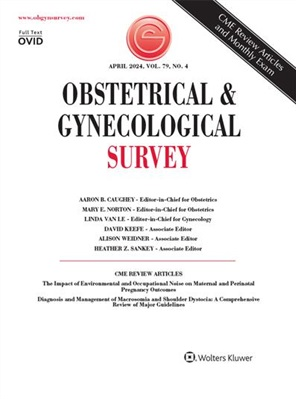US Infant Pertussis Incidence Trends Before and After Implementation of the Maternal Tetanus, Diphtheria, and Pertussis Vaccine
IF 3.6
4区 医学
Q1 OBSTETRICS & GYNECOLOGY
引用次数: 0
Abstract
ABSTRACT Many illnesses can become especially serious when contracted within the first year of life; pertussis remains quite deadly despite recent medical advances in disease prevention. Current guidance on vaccination in the United States includes 3 doses of the DTaP (diphtheria, tetanus toxoid, and acellular pertussis) vaccine beginning at 2 months of age, but this regimen leaves infants younger than that very vulnerable to illness. Research has shown both that vaccinating mothers with tetanus toxoid reduces tetanus, diphtheria, and pertussis (Tdap) between 27 and 36 weeks of gestation significantly reduces instances of pertussis in infants younger than 2 months, and that maternal vaccination rates have risen in the last few years. However, research is lacking in analyzing the relationship between vaccination rates in pregnant mothers and the burden of pertussis in infants in the United States. This study was designed to assess data from 2000 to 2019 and examine the association of Tdap vaccination during pregnancy with trends in infant pertussis. This analysis included data obtained from the National Notifiable Diseases Surveillance System between 2000 and 2019. This included a total of 57,460 cases of pertussis in infants younger than 1 year and a total of 19,322 cases in infants younger than 2 months. The rate of pertussis incidence for infants younger than 2 months in the time period before the implementation of prenatal Tdap was calculated to be 165.3 per 100,000 individuals, with no significant trend observed annually ( P = 0.28). After the implementation of routine maternal Tdap, incidence decreased to 80.9 per 100,000 infants between 2017 and 2019. Accounting for both time periods, the mean annual incidence was calculated as 121.8 per 100,000 infants younger than 2 months. Annual incidence also showed a significant decreasing trend in the period after implementation of maternal Tdap vaccination (slope: −14.53 per 100,000 infants per year; P = 0.001). The change in trends before and after this implementation was also significant ( P = 0.01). In a slightly older age group of 6 to 12 months of age, mean annual incidence of pertussis was 19.7 per 100,000 infants. In the time period before implementation of maternal Tdap, incidence among infants aged 6 to 12 months was consistently 4 to 12 times less than infants younger than 2 months and did not significantly change after the implementation of the maternal vaccine. Comparing the 2 age groups, there was no significant change in the difference in incidence between infants younger than 2 months and those between 6 and 12 months in the period before the maternal vaccine, and after its implementation, there was a significant decrease in the incidence difference between the 2 groups ( P < 0.001). These results suggest an association between the maternal Tdap vaccination and trends of pertussis incidence in infants younger than 2 months. This also indicates a possible reduction in disease burden attributable to maternal Tdap vaccination before delivery. Limitations of this study include limited availability of individual maternal vaccination status, as well as an inability to identify if any infants were vaccinated before the age of 2 months. Further research should focus on clinical impact of the Tdap vaccination in context with the later DTaP vaccination and on analyzing the trends in disease associated with both vaccinations. Clinical guidelines should also be examined to ensure that public health trends and individual health trends are in alignment.美国婴儿百日咳发病率趋势前后实施产妇破伤风,白喉,百日咳疫苗
许多疾病在生命的第一年感染时可能会变得特别严重;尽管最近在疾病预防方面取得了医学进步,百日咳仍然是相当致命的。美国目前的疫苗接种指南包括从2个月大开始接种3剂DTaP(白喉、破伤风类毒素和无细胞百日咳)疫苗,但这种方案使年龄小于2个月的婴儿非常容易患病。研究表明,为母亲接种破伤风类毒素疫苗可在妊娠27周至36周期间减少破伤风、白喉和百日咳(Tdap),显著减少2个月以下婴儿的百日咳病例,而且母亲疫苗接种率在过去几年中有所上升。然而,在美国,缺乏对孕妇疫苗接种率与婴儿百日咳负担之间关系的分析研究。本研究旨在评估2000年至2019年的数据,并检查怀孕期间接种百日咳疫苗与婴儿百日咳趋势的关系。该分析包括2000年至2019年期间从国家法定疾病监测系统获得的数据。其中包括1岁以下婴儿百日咳57,460例,2个月以下婴儿百日咳19,322例。在实施产前百日咳百日咳前,2个月以下婴儿百日咳发病率计算为每10万人165.3例,每年无显著趋势(P = 0.28)。在实施常规母亲百白破疫苗后,2017年至2019年期间,发病率降至每10万名婴儿80.9例。考虑到这两个时间段,计算出的年平均发病率为每10万名2个月以下婴儿121.8例。在实施母亲百白破疫苗接种后,年发病率也呈现显著下降趋势(斜率:- 14.53 / 10万婴儿/年;P = 0.001)。实施前后的趋势变化也很显著(P = 0.01)。在年龄稍大的6至12个月的年龄组中,百日咳的年平均发病率为每10万名婴儿19.7例。在实施母亲百白破疫苗之前,6至12个月婴儿的发病率始终比2个月以下婴儿低4至12倍,并且在实施母亲百白破疫苗后没有显着变化。两个年龄组比较,接种疫苗前2个月以下婴儿与6 ~ 12个月婴儿的发病率差异无显著变化,接种疫苗后两组发病率差异显著降低(P <0.001)。这些结果表明,母亲接种百日咳疫苗与2个月以下婴儿百日咳发病率趋势之间存在关联。这也表明,产妇在分娩前接种百白破疫苗可能会减少疾病负担。本研究的局限性包括个体母亲疫苗接种状况的有限可用性,以及无法确定是否有婴儿在2个月前接种过疫苗。进一步的研究应侧重于在后期接种百白破疫苗的背景下接种百白破疫苗的临床影响,并分析与两种疫苗接种相关的疾病趋势。还应审查临床指南,以确保公共卫生趋势和个人健康趋势相一致。
本文章由计算机程序翻译,如有差异,请以英文原文为准。
求助全文
约1分钟内获得全文
求助全文
来源期刊
CiteScore
2.70
自引率
3.20%
发文量
245
审稿时长
>12 weeks
期刊介绍:
Each monthly issue of Obstetrical & Gynecological Survey presents summaries of the most timely and clinically relevant research being published worldwide. These concise, easy-to-read summaries provide expert insight into how to apply the latest research to patient care. The accompanying editorial commentary puts the studies into perspective and supplies authoritative guidance. The result is a valuable, time-saving resource for busy clinicians.

 求助内容:
求助内容: 应助结果提醒方式:
应助结果提醒方式:


